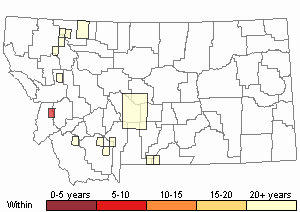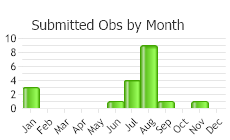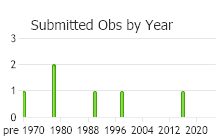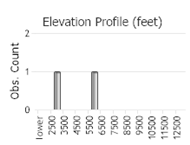View in other NatureServe Network Field Guides
NatureServe
Montana
Utah
Wyoming
Idaho
Wisconsin
British Columbia
South Carolina
Yukon
California
New York
A Ptychostomum Moss - Ptychostomum turbinatum
Other Names:
Bryum turbinatum
General Description
Plants: Acrocarpous (Vitt 1988). Growing in large, loose to crowded patches of upright shoots, green, occasionally with yellow tones (FNA 2014), sometimes reddish. Stems red, frequently forked proximally (Lawton 1971), mostly 2-4 cm tall (sometimes a little taller); rhizoids few on the stem, sometimes rhizoid bunches arising from lower leaf axils; fertile branches with leaves dense at the top of the stem (comose) (FNA 2014).
Leaves: Dense, strongly twisted and curved to contracted when dry, upright to spreading somewhat when wet, green or sometimes with yellow tones, 1-3 mm in length (FNA 2014), 0.4-0.7 mm in width (Lawton 1971), widely lance-shaped, tending toward egg-shaped, ending in an acumen or acute, more or less cupped, steadily becoming larger with height on the stem, green at the base; margins flat or faintly rolled back and downward proximally (FNA 2014), smooth or slightly toothed distally (Lawton 1971), bordered; costa extending to the leaf tip or slightly beyond to form a narrow awn (FNA 2014), generally longer in the upper leaves and shorter in the lower ones (Lawton 1971).
Leaf Cells: Border of 2-3 cell rows, parts of the proximal border with 2 cell layers; lower laminal cells quadrangular, 3-4:1; medial and upper cells thin-walled, diamond-shaped to 6-sided, 2-3:1 (FNA 2014).
Phenology
Fruit ripens in summer (FNA 2014).
Diagnostic Characteristics
Compared to the similar Bryum uliginosum, B. turbinatum is dioicous rather than autoicous, larger, and with more widely ovate leaves. The leaves of B. uliginosum are slenderly lance-shaped and somewhat ovate (FNA 2014).
Bryum weigelii resembles B. turbinatum, but has decurrencies that extend nearly to the next leaf below (FNA 2014).
Range Comments
North American Range
AK to NT, s to CA, NV, UT, and CO, also NL (FNA 2014).
Observations in Montana Natural Heritage Program Database
Number of Observations: 19
(Click on the following maps and charts to see full sized version)
Map Help and Descriptions
Relative Density

Recency



 (Observations spanning multiple months or years are excluded from time charts)
(Observations spanning multiple months or years are excluded from time charts)
Habitat
Wet soil of mountains (Lawton 1971 or calcareous wetlands. Elevation: 0-11,490 feet (FNA 2014).
Reproductive Characteristics
Dioicous. Seta mostly 10-40 mm tall, brown to russet. Capsule 3-5 mm in length, pear-shaped, light yellow to ochre, turning black with time, the opening yellow (FNA 2014) and strongly contracted when dry, drooping, the neck generally not as long as the rest of the capsule (Lawton 1971); peristome fully formed; exostome teeth yellow or reddish-yellow below, transparent above, without pores near the basal mid-line; endostome divisions with egg-shaped openings; cilia knobby to transversely ridged (FNA 2014).
No specialized vegetative reproduction present (FNA 2014).
Stewardship Responsibility
References
- Literature Cited AboveLegend:
 View Online Publication
View Online Publication Elliott, J.C. and A.K. Pipp. 2018. A Checklist of Montana Mosses (1880-2018). Updated 3 January, 2020. Montana Natural Heritage Program, Helena, Montana. 73 pp.
Elliott, J.C. and A.K. Pipp. 2018. A Checklist of Montana Mosses (1880-2018). Updated 3 January, 2020. Montana Natural Heritage Program, Helena, Montana. 73 pp. Flora of North America Editorial Committee, eds. 2014. Flora of North America North of Mexico. Volume 28. Bryophytes: Mosses, Part 2. Oxford University Press, Inc., NY. xxi + 702 pp.
Flora of North America Editorial Committee, eds. 2014. Flora of North America North of Mexico. Volume 28. Bryophytes: Mosses, Part 2. Oxford University Press, Inc., NY. xxi + 702 pp. Lawton, E. 1971. Moss Flora of the Pacific Northwest. Hattori Botanical Laboratory. Japan: Yamabuki-cho, Shinjuku-ku, Tokyo. 362 pages plus appendices.
Lawton, E. 1971. Moss Flora of the Pacific Northwest. Hattori Botanical Laboratory. Japan: Yamabuki-cho, Shinjuku-ku, Tokyo. 362 pages plus appendices.
- Additional ReferencesLegend:
 View Online Publication
View Online Publication
Do you know of a citation we're missing? Crum, H.A. and L.E. Anderson. 1981. Mosses of Eastern North America. 2 volumes. Columbia University Press, New York. 1328 pp.
Crum, H.A. and L.E. Anderson. 1981. Mosses of Eastern North America. 2 volumes. Columbia University Press, New York. 1328 pp. Elliot, J. C. 1993. Second checklist of Montana mosses. Unpublished report. U.S. Forest Service, Region 1. Missoula, MT. 45 pp.
Elliot, J. C. 1993. Second checklist of Montana mosses. Unpublished report. U.S. Forest Service, Region 1. Missoula, MT. 45 pp. Flowers, S. 1973. Mosses: Utah and the West. Brigham Young University, Provo, Utah. 567 p.
Flowers, S. 1973. Mosses: Utah and the West. Brigham Young University, Provo, Utah. 567 p. Lawton, E. 1971. Keys for the Identification of the Mosses on the Pacific Northwest. Reprinted from 'Moss Flora of the Pacific Northwest'. Published as Supplement No. 2 of the Journal of the Hattori Botanical Laboratory. Nichinan, Miyazaki, Japan. 66 pp.
Lawton, E. 1971. Keys for the Identification of the Mosses on the Pacific Northwest. Reprinted from 'Moss Flora of the Pacific Northwest'. Published as Supplement No. 2 of the Journal of the Hattori Botanical Laboratory. Nichinan, Miyazaki, Japan. 66 pp. Malcolm, B., N. Malcolm, J. Shevock, and D. Norris. 2009. California Mosses. Nelson, New Zealand: Micro-Optics Press. 430 pp.
Malcolm, B., N. Malcolm, J. Shevock, and D. Norris. 2009. California Mosses. Nelson, New Zealand: Micro-Optics Press. 430 pp. Smith, A.J.E. 1980. The Moss Flora of Britain and Ireland. Cambridge University Press, Cambridge. 705 pp.
Smith, A.J.E. 1980. The Moss Flora of Britain and Ireland. Cambridge University Press, Cambridge. 705 pp. Vitt, D. J. Marsh, and R. Bovey. 1988. Mosses, Lichens & Ferns of Northwest North America. Seattle, WA: University of Washington Press. 296 p.
Vitt, D. J. Marsh, and R. Bovey. 1988. Mosses, Lichens & Ferns of Northwest North America. Seattle, WA: University of Washington Press. 296 p.
- Web Search Engines for Articles on "A Ptychostomum Moss"





